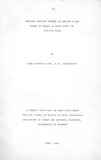| dc.description.abstract | The focus of the study is on housing demand
in Kericho. Housing demand is a function of income
and the proportion of it that people are able and
willing to spend on housing and the cost at which
housing units are provided. It is considered normal
in Kenya for people to spend 20% of their incomes on
housing.
This study has, therefore, endeavoured first
to establish the average income levels in Kericho Town
and the proportion of such incomes spent on housing.
Secondly, the study has focused on the issue of housing
affordability. Another aspect covered in this study
is the housing stock situation in Kericho town and
the rate at which new units are being produced. And
lastly, the study has attempted to analyse the
housing need situation in Kericho Town.
Analysis in this study reveals that people in
Kericho spend an average of 26% of their incomes
on housing. And when related to the rent levels
and housing mortgage requirements, it becomes clear
that majority of the people, especially the income,
cannot afford suitable housing and this explains
why most of them live in the Kwa Michael and Nyagacho
areas. By considering current eosts in a site and
service scheme and of putting up a two-roomed houses
acc~ptable to the Council, as regards standards of
construction and infrastructure, it has been
established in this study that the low and middlie
income earners in Kericho cannot afford loan repayments,
if given loans, mainly as a result of their low incomes
relative to the national levels and high standards
emphasised by local authorities.
The study has also revealed the inadequacy
of housing units in Kericho town. By comparing the
level of housing stock, the rates at which new units
are being produced and'the rate of formation of new
households, it has been established that there is
a large housing need in Kericho town and that most
of these needs are to meet the housing requirements
of the low income.
After consideration of what people can afford
in Kericho town, it has been established that the
current programmes oriented towards home ownership
in urban are~s, for example, the site and service;,
programmes, are not actually benefiting the target
beneficiaries - the low-income earners. This study
has thus emphasized the shift of emphasis from owner occupier
developments, to putting up rental houses.
if the low income are to afford living in houses
that meet the standards required by local authorities.
So in a nut-shell, this study reveals the
inadequacy of affordable housing and which
measure to the standards required by local authorities,
in terms of rents and housing mortgage terms, especially
to the low and a section of the middle income and
groups. | en_US |

